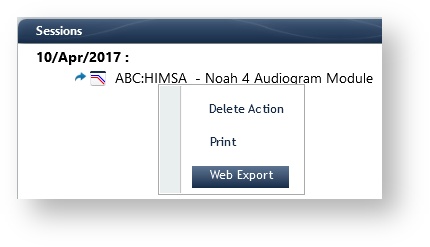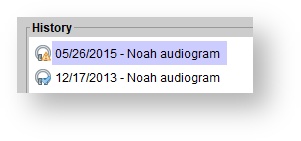Versions Compared
| Version | Old Version 30 | New Version 31 |
|---|---|---|
| Changes made by | ||
| Saved on |
Key
- This line was added.
- This line was removed.
- Formatting was changed.
Exporting patients to Noah
| Tip |
|---|
Upon creating a new patient in Blueprint OMS, the patient can be exported to Noah. See: Entering new patients. The export can also occur at a later time. |
On the Patient browser, do one of the following:
Highlight a patient name.
Open a patient file.
From the Noah drop-down menu, select Export patient to Noah.
 Image Removed
Image Removed Image Added
Image Added3. A confirmation message appears when the patient is successfully exported
| Tip |
|---|
It may take up to 15 seconds to see the patient file in Noah. |
| Note |
|---|
If the patient already exists in Noah, and already exists in Blueprint OMS, the two files will be automatically linked as long as the spelling of the patient's first name, last name, and date of birth are identical. |
Patient data that transfers from Blueprint OMS to Noah
First name
Last name
Middle initial
Gender
Birthdate
SSN
Creation date
Address
City
Zip
Province
Country
Email
Home telephone number
Work telephone number
Mobile telephone number
Primary physician
Automatically importing audiometric data into Blueprint OMS
Open the patient file in Noah and perform the hearing assessment.
When complete, save the test results in Noah.
The audiometric data automatically populates in Blueprint OMS within the patient’s Audiology tab.
| Tip | ||||
|---|---|---|---|---|
Click
|
Manually importing audiometric data into Blueprint OMS
If you need to import the audiometric data from Noah into Blueprint OMS at a later time you can follow the instructions below:
Open the patient file in Noah
R-click the hearing assessment
Select Web Export
The audiometric data will populate in Blueprint OMS within the patient’s Audiology tab.
 Image Removed
Image Removed Image Added
Image AddedCompleting the data set
| Tip |
|---|
The  Image Removed Image Removed yellow-triangle symbol next to the assessment date in the patient's Audiology tab indicates an incomplete data set. |
Double-click on the assessment in the History panel.
 Image Removed
Image Removed Image Added
Image AddedIn the Edit test results dialog box, select the Provider, Test Method, hearing loss Severity, Type, and Shape.
Enter diagnostic codes as desired using the
button. See: Patient hearing assessments.Status title Add ICD code(s)
| Tip |
|---|
Click the Copy |
Click
.Status title save
Deleting the data set
In the History panel, right-click on the data set you wish to delete, and select Delete.
 Image Removed
Image Removed Image Added
Image Added| Panel | ||||||
|---|---|---|---|---|---|---|
| ||||||
|
| Panel | ||||||||||||
|---|---|---|---|---|---|---|---|---|---|---|---|---|
| ||||||||||||
|
| Panel | ||||||
|---|---|---|---|---|---|---|
| ||||||
